View in other NatureServe Network Field Guides
NatureServe
Montana
Utah
Wyoming
Idaho
Wisconsin
British Columbia
South Carolina
Yukon
California
New York
Narrowleaf Penstemon - Penstemon angustifolius
State Rank Reason (see State Rank above)
Over a dozen, small extant and/or presumed extant occurrences are known in southeast Montana, plus a few historical collections from the same area. Only one of the known populations appears to be relatively large. Additional suitable, but unsurveyed habitat likely exists in eastern Montana.
- Details on Status Ranking and Review
Population Size
Score2-3 - Very Small to Small: Population size is imprecisely known but is believed to be <10,000 individuals.
CommentMost occurrences are reported to have only a few plants up to a maximum of several dozen plants observed. The species was reported to be common at a few additional sites.
Range Extent
Score1-2 - Sporadic Distribution/Regional Endemic: Species is limited in distribution but is either too poorly documented or the information to precisely categorize it was lacking at the time its status was reviewed.
Area of Occupancy
Score2 - Low: Generally occurring in 4-10 Subwatersheds (6th Code HUC’s).
Environmental Specificity
Score1-2 - Moderate to High.
CommentSandy soils, particulary in sandy blowouts.
Trends
ScoreNA - Rank factor not assessed.
Threats
Score0-1 - Low to Medium.
Intrinsic Vulnerability
Score1 - Moderate Vulnerability: Specific biological attributes, unusual life history characteristics or limited reproductive potential makes the species susceptible to extirpation from stochastic events or other adverse impacts to its habitat and slow to recover.
Raw Conservation Status Score
Score
7 to 11 total points scored out of a possible 16 (Rarity factors and threats only).
General Description
Narrowleaf Penstemon is a perennial herb with usually 1 erect stem 15-45 cm tall which arises from a taproot surmounted by a branched, woody crown. Basal leaves are 4-9 cm long and strap or narrowly lance-shaped with short petioles and entire margins. The opposite stem leaves are just as long but lack petioles. Foliage is glabrous, somewhat thickish, and often covered with a thin coat of bluish wax. The inflorescence consists of clusters of several short-stalked flowers in the axils of the reduced upper leaves. The tubular corolla is flared and 2-lipped at the mouth, 14-20 (23) mm long, and pink to lavender or bright blue, and glabrous externally. The 5 narrowly lance-shaped sepals are 4-8 mm long and have a narrow white margin. The 4 anthers are glabrous.
Our plants are variety angustifolius.
Phenology
Flowering in May-June.
Diagnostic Characteristics
The only other Penstemons in eastern Montana with a glabrous corollas are P. nitidus and P. grandiflorus but neither have linear leaves.
Species Range
Montana Range
Range Descriptions
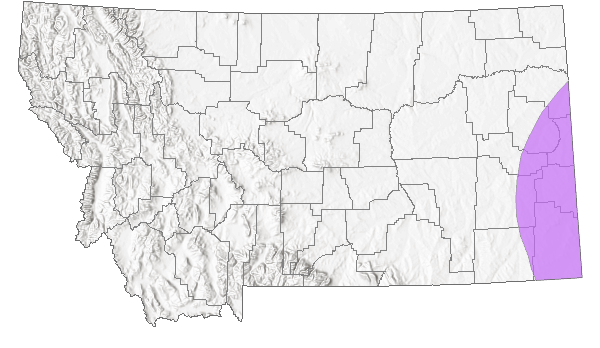
 Native
Native
Range Comments
Great Plains, from ND to MT, and south from OK to AZ. Peripheral.
Observations in Montana Natural Heritage Program Database
Number of Observations: 62
(Click on the following maps and charts to see full sized version)
Map Help and Descriptions
Relative Density
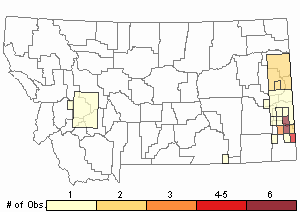
Recency
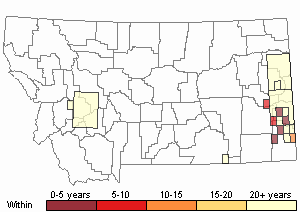
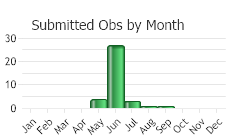

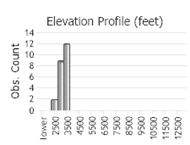 (Observations spanning multiple months or years are excluded from time charts)
(Observations spanning multiple months or years are excluded from time charts)
Habitat
Sandy-soiled, prairie grasslands on hills and slopes. Plants are often most abundant on sandy blowouts and other sparsely-vegetated areas. Common associated species include Andropogon scoparius, Bouteloua gracilis, Carex filifolia, Stipa comata, Calamovilfa longifolia, Tradescantia occidentalis, Artemisia campestris, Artemisia frigida, Heterotheca villosa, Helianthus rigidus and Yucca glauca.
National Vegetation Classification System Groups Associated with this Species
Grassland
Lowland - Prairie Grassland
Ecology
Penstemon angustifolius is a short-lived perennial.
POLLINATORS The following animal species have been reported as pollinators of this plant species or its genus where their geographic ranges overlap:
Bombus vagans,
Bombus appositus,
Bombus auricomus,
Bombus bifarius,
Bombus centralis,
Bombus fervidus,
Bombus flavifrons,
Bombus frigidus,
Bombus huntii,
Bombus melanopygus,
Bombus mixtus,
Bombus nevadensis,
Bombus rufocinctus,
Bombus sylvicola,
Bombus occidentalis,
Bombus pensylvanicus,
Bombus bimaculatus,
Bombus griseocollis,
Bombus impatiens,
Bombus insularis,
Bombus suckleyi,
Bombus bohemicus, and
Bombus kirbiellus (Macior 1974, Thorp et al. 1983, Bauer 1983, Mayer et al. 2000, Wilson et al. 2010, Colla and Dumesh 2010, Colla et al. 2011, Koch et al. 2012, Pyke et al. 2012, Miller-Struttmann and Galen 2014, Williams et al. 2014, Tripoldi and Szalanski 2015).
Stewardship Responsibility
Threats or Limiting Factors
STATE THREAT SCORE REASON
Threat impact not assigned because threats are not known (MTNHP Threat Assessment 2021).
References
- Literature Cited AboveLegend:
 View Online Publication
View Online Publication Bauer, P.J. 1983. Bumblebee pollination relationships on the Beartooth Plateau tundra of Southern Montana. American Journal of Botany. 70(1): 134-144.
Bauer, P.J. 1983. Bumblebee pollination relationships on the Beartooth Plateau tundra of Southern Montana. American Journal of Botany. 70(1): 134-144. Colla, S., L. Richardson, and P. Williams. 2011. Bumble bees of the eastern United States. Washington, DC: USDA Forest Service, Pollinator Partnership. 103 p.
Colla, S., L. Richardson, and P. Williams. 2011. Bumble bees of the eastern United States. Washington, DC: USDA Forest Service, Pollinator Partnership. 103 p. Colla, S.R. and S. Dumesh. 2010. The bumble bees of southern Ontario: notes on natural history and distribution. Journal of the Entomological Society of Ontario 141:39-68.
Colla, S.R. and S. Dumesh. 2010. The bumble bees of southern Ontario: notes on natural history and distribution. Journal of the Entomological Society of Ontario 141:39-68. Koch, J., J. Strange, and P. Williams. 2012. Bumble bees of the western United States. Washington, DC: USDA Forest Service, Pollinator Partnership. 143 p.
Koch, J., J. Strange, and P. Williams. 2012. Bumble bees of the western United States. Washington, DC: USDA Forest Service, Pollinator Partnership. 143 p. Macior, L.M. 1974. Pollination ecology of the Front Range of the Colorado Rocky Mountains. Melanderia 15: 1-59.
Macior, L.M. 1974. Pollination ecology of the Front Range of the Colorado Rocky Mountains. Melanderia 15: 1-59. Mayer, D.F., E.R. Miliczky, B.F. Finnigan, and C.A. Johnson. 2000. The bee fauna (Hymenoptera: Apoidea) of southeastern Washington. Journal of the Entomological Society of British Columbia 97: 25-31.
Mayer, D.F., E.R. Miliczky, B.F. Finnigan, and C.A. Johnson. 2000. The bee fauna (Hymenoptera: Apoidea) of southeastern Washington. Journal of the Entomological Society of British Columbia 97: 25-31. Miller-Struttmann, N.E. and C. Galen. 2014. High-altitude multi-taskers: bumble bee food plant use broadens along an altitudinal productivity gradient. Oecologia 176:1033-1045.
Miller-Struttmann, N.E. and C. Galen. 2014. High-altitude multi-taskers: bumble bee food plant use broadens along an altitudinal productivity gradient. Oecologia 176:1033-1045. MTNHP Threat Assessment. 2021. State Threat Score Assignment and Assessment of Reported Threats from 2006 to 2021 for State-listed Vascular Plants. Botany Program, Montana Natural Heritage Program, Helena, Montana.
MTNHP Threat Assessment. 2021. State Threat Score Assignment and Assessment of Reported Threats from 2006 to 2021 for State-listed Vascular Plants. Botany Program, Montana Natural Heritage Program, Helena, Montana. Pyke, G.H., D.W. Inouye, and J.D. Thomson. 2012. Local geographic distributions of bumble bees near Crested Butte, Colorado: competition and community structure revisited. Environmental Entomology 41(6): 1332-1349.
Pyke, G.H., D.W. Inouye, and J.D. Thomson. 2012. Local geographic distributions of bumble bees near Crested Butte, Colorado: competition and community structure revisited. Environmental Entomology 41(6): 1332-1349. Thorp, R.W., D.S. Horning, and L.L. Dunning. 1983. Bumble bees and cuckoo bumble bees of California (Hymenoptera: Apidae). Bulletin of the California Insect Survey 23:1-79.
Thorp, R.W., D.S. Horning, and L.L. Dunning. 1983. Bumble bees and cuckoo bumble bees of California (Hymenoptera: Apidae). Bulletin of the California Insect Survey 23:1-79. Tripoldi, A.D. and A.L. Szalanski. 2015. The bumble bees (Hymenoptera: Apidae: Bombus) of Arkansas, fifty years later. Journal of Melittology 50: doi: http://dx.doi.org/10.17161/jom.v0i50.4834
Tripoldi, A.D. and A.L. Szalanski. 2015. The bumble bees (Hymenoptera: Apidae: Bombus) of Arkansas, fifty years later. Journal of Melittology 50: doi: http://dx.doi.org/10.17161/jom.v0i50.4834 Williams, P., R. Thorp, L. Richardson, and S. Colla. 2014. Bumble Bees of North America. Princeton, NJ: Princeton University Press. 208 p.
Williams, P., R. Thorp, L. Richardson, and S. Colla. 2014. Bumble Bees of North America. Princeton, NJ: Princeton University Press. 208 p. Wilson, J.S., L.E. Wilson, L.D. Loftis, and T. Griswold. 2010. The montane bee fauna of north central Washington, USA, with floral associations. Western North American Naturalist 70(2): 198-207.
Wilson, J.S., L.E. Wilson, L.D. Loftis, and T. Griswold. 2010. The montane bee fauna of north central Washington, USA, with floral associations. Western North American Naturalist 70(2): 198-207.
- Additional ReferencesLegend:
 View Online Publication
View Online Publication
Do you know of a citation we're missing? Heidel, B.L. and K.H. Dueholm. 1995. Sensitive plant survey in the Sioux District, Custer National Forest, 1994, Carter County, Montana and Harding County, South Dakota. Unpublished report to the Custer National Forest. Montana Natural Heritage Program, Helena, Montana. 95 pp. plus appendices.
Heidel, B.L. and K.H. Dueholm. 1995. Sensitive plant survey in the Sioux District, Custer National Forest, 1994, Carter County, Montana and Harding County, South Dakota. Unpublished report to the Custer National Forest. Montana Natural Heritage Program, Helena, Montana. 95 pp. plus appendices. Lesica, P., M.T. Lavin, and P.F. Stickney. 2012. Manual of Montana Vascular Plants. Fort Worth, TX: BRIT Press. viii + 771 p.
Lesica, P., M.T. Lavin, and P.F. Stickney. 2012. Manual of Montana Vascular Plants. Fort Worth, TX: BRIT Press. viii + 771 p. Lesica, P., M.T. Lavin, and P.F. Stickney. 2022. Manual of Montana Vascular Plants, Second Edition. Fort Worth, TX: BRIT Press. viii + 779 p.
Lesica, P., M.T. Lavin, and P.F. Stickney. 2022. Manual of Montana Vascular Plants, Second Edition. Fort Worth, TX: BRIT Press. viii + 779 p. Strickler, D. 1997. Northwest penstemons. Flower Press, Columbia Falls, Montana. 191 pages.
Strickler, D. 1997. Northwest penstemons. Flower Press, Columbia Falls, Montana. 191 pages. Vanderhorst, J.P., S.V. Cooper, and B.L. Heidel. 1998. Botanical and vegetation survey of Carter County, Montana. Unpublished report prepared for the Bureau of Land Management. Montana Natural Heritage Program, Helena. 116 pp. + app.
Vanderhorst, J.P., S.V. Cooper, and B.L. Heidel. 1998. Botanical and vegetation survey of Carter County, Montana. Unpublished report prepared for the Bureau of Land Management. Montana Natural Heritage Program, Helena. 116 pp. + app.
- Web Search Engines for Articles on "Narrowleaf Penstemon"





